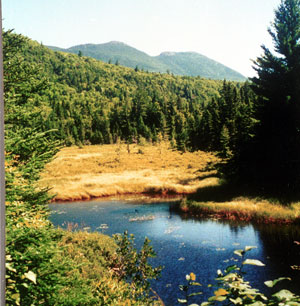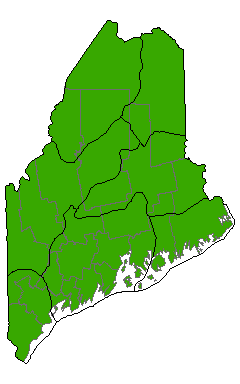DACF Home → Bureaus & Programs → Maine Natural Areas Program → Communities, Plants, and Animals → Natural Community Fact Sheets → Grassy Shrub Marsh
Printer Friendly Fact Sheet - 700 KB pdf (Get a free copy of Adobe Acrobat Reader)
Grassy Shrub Marsh
Scientific Name: Mixed Graminoid - Shrub Marsh; State Rank: S5

- Community Description
- Soil and Site Characteristics
- Diagnostics
- Similar Types
- Conservation, Wildlife and Management Considerations
- Distribution
- Characteristic Plants
- Associated Rare Plants
- Associated Rare Animals
- Examples on Conservation Lands You Can Visit
Community Description: This is a heterogeneous wetland type in which herbs and shrubs occur in various assemblages and proportions. Many examples are transitional to other open wetland types. A variant in southern Maine has buttonbush as a prominent shrub. The more typical expression is dominated by herbs, with a mixture of graminoids making up at least 50% of the cover, often with a sparse shrub layer containing meadowsweet or hardhack. Bluejoint is frequent, but not in large swards. Any of a variety of graminoids may be prominent at different sites. Three-way sedge and yellow loosestrife are indicators. Bryophytes are generally minor. This type is very broadly defined and could be subdivided into shrub versus herbaceous types using additional site data and analyses. Back to top.
Soil and Site Characteristics: Sites are typically on mineral soils that are flooded early in the growing season and remain saturated (or occasionally flooded) throughout the season. Soil pH is typically 5.0-6.0. Beaver activity often affects these wetlands, and can cause dramatic (although sometimes temporary) changes in dominance. Back to top.
Diagnostics: Herb and shrub wetland species are mixed (herbs 25-95%, shrubs 0-70% cover), without a dominance of tussock sedge, bluejoint grass, or alder. Sites occur on mineral soil (may have a thick organic layer of muck). Red maple may be occasional in sapling form. Mountain holly, dogwoods, or alder are often dominant shrubs; sweetgale and leatherleaf are frequent but usually total less than 50% cover. Back to top.
Similar Types: Sweetgale Fens are similar, but occur on organic soils and have plants more characteristic of peatlands, such as rhodora, sheep laurel, Labrador tea, bog rosemary, or pitcher plants. Those plants may be present in this type, but form <1% cover. Sedge Meadows and Tall Grass Meadows are strongly dominated by tussock sedge and bluejoint, respectively. Alder Thickets have >20% cover of alder or alder mixed with gray birch. Outwash Plain Pondshores share diagnostic species but occur on sandy shores and contain other characteristic species. Back to top.
Conservation, Wildlife and Management Considerations: These marshes are well distributed throughout Maine and well represented on public lands and private conservation lands. Maintaining appropriate wetland buffers can help ensure that adjacent land uses do not degrade the marshes.
Several rare reptiles may be found in this community type. The ribbon snake seeks out prey in these wetlands. In Southern Maine, spotted turtles and Blanding’s turtles may overwinter in marshes where water levels remain reliably deep throughout most years. Some occurrences may function as vernal pools, which provide important breeding habitat for a variety of amphibians including wood frogs, spotted salamanders, and blue-spotted salamanders. These wetlands provide nesting and foraging habitat for a number of wading birds including the green heron, American bittern, and the rare least bittern. The rare sedge wren nests in graminoid marshes and wet meadows. Back to top.
Distribution: Statewide, extending southward, westward, and into Canada. Landscape Pattern: Small to Large Patch. Back to top.


Characteristic Plants: These plants are frequently found in this community type. Those with an asterisk are often diagnostic of this community.
- Sapling/shrub
- Bog willow*
- Winterberry
- Mountain holly
- Buttonbush*
- Meadowsweet*
- Redosier dogwood*
- Speckled alder*
- Sweetgale*
- Dwarf Shrub
- Leatherleaf*
- Sweetgale*
- Herb
- Beaked sedge*
- Black bulrush*
- Bluejoint*
- Expanded bulrush*
- Few-seeded sedge*
- Marsh St. Johnswort*
- Royal fern*
- Sensitive fern*
- Three-way sedge*
- Wool-grass*
- Yellow loosestrife*
- Bryoid
- Sphagnum mosses*
- Black-crowned night-heron
- Blanding's turtle
- Least bittern
- Ribbon snake
- Sedge wren
- Short-eared owl
- Spotted turtle
Examples on Conservation Lands You Can Visit
| Example | County |
|---|---|
| Kennebec Crossing, Appalachian Trail | Somerset Co. |
| Mt Agamenticus | York Co. |
| Stratton Brook Pond, Bigelow Preserve | Franklin Co. |
| Tunk Lake Area, Donnell Pond Public Lands | Hancock Co. |